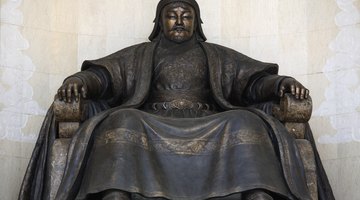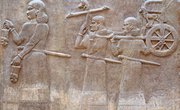Attila the Hun. Genghis Khan. Those names stirred fear nearly worldwide hundreds of years ago, and even today their names are synonymous with brutality and "take no prisoners" warfare. But there are distinct differences, though both gobbled up land and changed drastically the way war was waged. Today, the name Atilla is synonymous with barbarianism. Although Genghis Khan was also brutal and merciless, he is seen by many as a great military strategist who expanded trade, communication and religious freedom during his reign.
Attila the Hun
Attila was born in what is now Hungary in about 406. Attila became sole ruler of the Huns after murdering his brother Bleda, his co-ruler. While he was intelligent and simple in his dress and habits, he had a violent temper. Attila ruled over a large group of Germanic people, and he used his army to attack the Roman empire, both on the western front and the eastern front, in order to exact a tribute from the leaders. He was paid handsomely for his efforts -- 2,000 pounds of gold yearly from Constantinople, for example -- but when he felt the tributes weren't enough, he would attack, not always completely successfully. When Attila died on one of his wedding nights, perhaps from a hemorrhage, his sons fought among themselves for his empire, but they were never able to match their father's ferocity.
Style of Warfare
Attila's style of warfare gave him the advantage for two reasons. First, all of his soldiers were on horseback, which the Roman soldiers he was constantly fighting had never seen and were not prepared for. Roman leaders believed large numbers of foot soldiers would carry the day. Second, Attila was not interested in prolonged warfare or sieges, which was the style of warfare in the early part of the fifth century. Instead, he struck quickly and brutally, gathering as much booty and prisoners as possible, and then disappearing, having extracted the promise of a tribute in exchange for no further attacks.
Genghis Khan
Genghis Khan was born Temujin in what is now Mongolia around 1162. His father was poisoned by a rival tribe when Temujin was 9. He had to fight with the other Mongolian tribes for dominance, winning complete control and raising a fearsome army by the time he was 20. He was a ruthless fighter. After securing allegiance from the other Mongolian tribesman, Temujin -- now called Genghis Khan -- went on to conquer China, Central Asia, the Middle East and parts of Europe. He died around age 60, probably from injuries after falling off a horse some months before his death.
Style of Battle
Genghis Khan was a brilliant strategist in battle. He had a huge network of spies, which he sent out to the territory he wanted to conquer. He looked for weaknesses in their armies, and that was the exact point where he would launch his attack. Like Attila, Genghis Khan's armies were mounted. But unlike Attila, Genghis Khan's armies fought to conquer, not to raid. The armies were also diversified: Some soldiers carried bows and arrows, some wore armor and carried swords. They killed or captured nearly everyone in their path. Any inhabitants of a city captured by the Mongols had no thoughts of resistance. By contrast, the Romans paid the Huns off, which worked to keep Atilla at bay.
Related Articles
References
Writer Bio
Lori Garrett-Hatfield has a B.J. in Journalism from the University of Missouri. She has a Ph.D. in Adult Education from the University of Georgia. She has been working in the Education field since 1994, and has taught every grade level in the K-12 system, specializing in English education, and English as a Second Language education.











